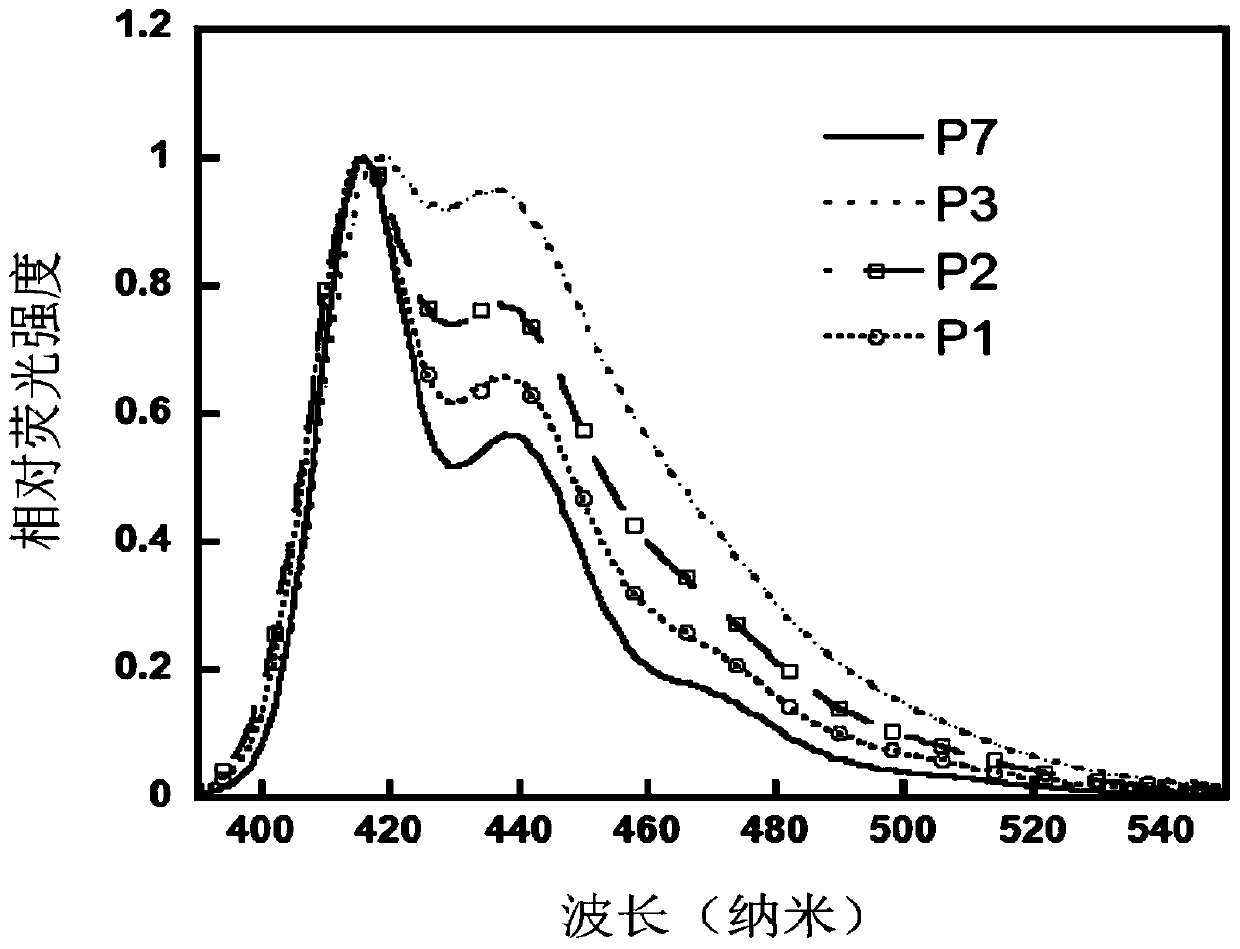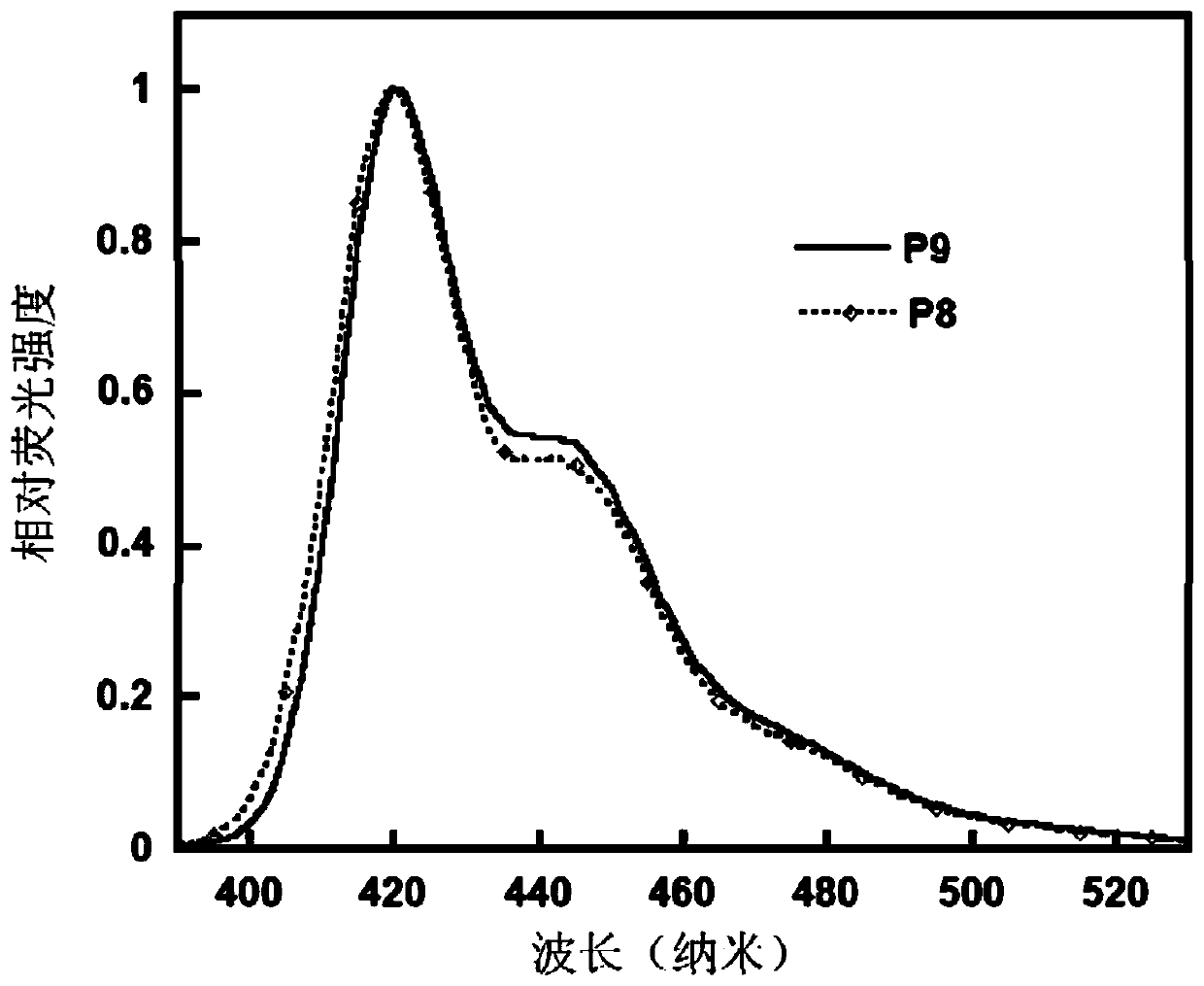Electroluminescent polymer and preparation method and application thereof
A luminescence and polymer technology, applied in circuits, electrical components, electrical solid devices, etc., can solve the problems of polymers that have not been clearly disclosed, and achieve excellent thermal stability, high-efficiency and stable performance of light-emitting devices, and good planarity Effect
- Summary
- Abstract
- Description
- Claims
- Application Information
AI Technical Summary
Problems solved by technology
Method used
Image
Examples
preparation example Construction
[0058] 1. Preparation of polymerized monomers
[0059] Preparation of 1-bromo-4-phenylnaphthalene
[0060] Under an argon atmosphere, into a 500mL three-necked flask, add 1,4-dibromonaphthalene (9.68g, 34.1mmol), phenylboronic acid ester (4.63g, 22.3mmol), catalyst tetrakistriphenylphosphine palladium (0.52g , 0.45mmol) and 180mL tetrahydrofuran, stir and heat, when the temperature is stabilized at 80°C, add 50wt% K 2 CO 3 (24.6g, 0.18mol) aqueous solution 24.6mL, reacted for 12h. After the reaction solution was concentrated, it was purified by silica gel column chromatography, using a mixed solvent of petroleum ether and dichloromethane (8 / 1, v / v) as eluent, to obtain a light yellow solid with a yield of 72%. 1 H NMR, 13 CNMR, MS and elemental analysis results show that the obtained compound is the target product, and the chemical reaction equation of the preparation process is as follows:
[0061]
[0062] Preparation of 1-bromo-4-(4-bromophenyl)naphthalene
[0063]...
Embodiment example 1
[0078] Synthesis of Example 1 Polymer P1
[0079] Under argon atmosphere, 2,7-bis(4,4,5,5-tetramethyl-1,3,2-dioxaborolane-diyl)-9,9-dioctylfluorene ( 321mg, 0.50mmol), 2,7-dibromo-9,9-dioctylfluorene (263.3mg, 0.48mmol) and the polymerized monomer unit M1 (8.4mg, 0.02mmol) were added to a 50ml two-necked bottle, and then Add 12ml of refined toluene (toluene treated with concentrated sulfuric acid), then add palladium acetate (2.80mg, 12.45μmol) and tricyclohexylphosphine (6.98mg, 24.90μmol), then add 3ml of tetraethylammonium hydroxide aqueous solution (mass Fraction is 20%), heat up to 80 ℃, react for 24 hours; then add 24.3mg phenylboronic acid to carry out capping, after 12 hours, then use 0.1ml bromobenzene to carry out capping; after continuing to react for 12 hours, stop the reaction, and Cool down to room temperature, add the product dropwise to 300ml of methanol for precipitation, filter, then dissolve the crude product in 20mL of toluene, use 200-300 mesh silica gel ...
Embodiment example 2
[0083] Synthesis of Example 2 Polymer P2
[0084] Under argon atmosphere, 2,7-bis(4,4,5,5-tetramethyl-1,3,2-dioxaborolane-diyl)-9,9-dioctylfluorene ( 321mg, 0.50mmol), 2,7-dibromo-9,9-dioctylfluorene (246.8mg, 0.45mmol) and the polymerized monomer unit M1 (21.1mg, 0.05mmol) were added to a 50ml two-necked bottle, and then Add 12ml refined toluene, then add palladium acetate (2.80mg, 12.45μmol) and tricyclohexylphosphine (6.98mg, 24.90μmol), then add 3ml tetraethylammonium hydroxide aqueous solution (mass fraction is 20%), heat up to 80 ℃, reacted for 24 hours; then added 24.3mg of phenylboronic acid for capping, and after 12 hours, 0.1ml of bromobenzene was used for capping; after continuing the reaction for 12 hours, stop the reaction, and when the temperature dropped to room temperature, the product was added dropwise in Precipitate in 300ml of methanol, filter, then dissolve the crude product in 20mL of toluene, use 200-300 mesh silica gel as the stationary phase, and use ...
PUM
| Property | Measurement | Unit |
|---|---|---|
| Glass transition temperature | aaaaa | aaaaa |
| Maximum lumen efficiency | aaaaa | aaaaa |
| Brightness | aaaaa | aaaaa |
Abstract
Description
Claims
Application Information
 Login to View More
Login to View More - Generate Ideas
- Intellectual Property
- Life Sciences
- Materials
- Tech Scout
- Unparalleled Data Quality
- Higher Quality Content
- 60% Fewer Hallucinations
Browse by: Latest US Patents, China's latest patents, Technical Efficacy Thesaurus, Application Domain, Technology Topic, Popular Technical Reports.
© 2025 PatSnap. All rights reserved.Legal|Privacy policy|Modern Slavery Act Transparency Statement|Sitemap|About US| Contact US: help@patsnap.com



